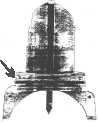The Gun - Smoothbore Era 1550-1860: Sights and Laying | |
At first guns had no sights of any kind. To lay for line the layer (who was the Number One) merely looked along the 'line of metal', ie along the top of the piece, to align gun and target. As can be imagined, with nothing to clearly define the straight line, the lay was pretty rough. To remedy this defect, gunmakers cut grooves, one in the centre of the base ring and another on the muzzle, to act as backsight and foresight respectively. Then the experts claimed that if the grooves were used to lay a gun on uneven ground, ie with one trunnion higher than the other, or in other words with the vertical plane through the sight line tilted, a line error would result. So they ordered the cutting of grooves to cease. Instead, on coming into action Gunners were trained to use a level, to find the centres of the base ring and muzzle, mark them with chalk lines, and use the latter as sights with which to lay the gun for line. This drill endured until late in the 18th century. By this time an instrument called a perpendicular incorporating a spirit level had been introduced for the same purpose. But by then field Gunners had concluded that the time spent fiddling with level or perpendicular and chalk lines was not justified, that removal of a few shovelfuls of earth from under the higher gun wheel, thus levelling the trunnions by eye, was the better answer, where seed rather than precision was the criterion. So the cutting of grooves on base ring and muzzle was resumed. |
|
|
With garrison or coastal artillery the problem did not arise because guns were always emplaced on carefully levelled platforms. Similarly, in siege operations where time spent was rarely critical, guns were brought into action on previously levelled platforms. There were many variations of the instruments shown here. | |
|
WL Ruffell previous | index | next | History index | Home | |


